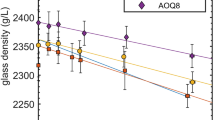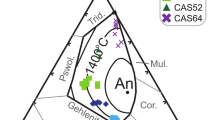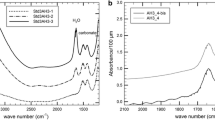Abstract
Experimental studies have been performed to constrain sulfur behavior during apatite crystallization and to determine sulfur partition coefficient between apatite and melt (Kd apatite/meltS ) at oxidizing conditions. Crystallization experiments have been conducted with a hydrous rhyolitic melt and different bulk sulfur contents (0.15 to 2 wt.% S) at 900 and 1,000°C, 200 MPa and Δlog \(f_{{{\rm O}_{2} }} \)=NNO+3.6. The sulfur content in the glass increases with increasing amount of added S. Anhydrite crystallizes for S added = 0.75 wt.% (0.10 and 0.13 wt.% SO3 in glass at 900 and 1,000°C, respectively). The amount of anhydrite increases and the amount of apatite decreases with increasing amount of added sulfur. The sulfur exchange reaction in apatite is influenced by the bulk composition of the melt (e.g., P content). However, changing melt composition has only little effect on Kd apatite/meltS for the investigated rhyolitic composition. The Kd apatite/meltS does not depend directly on temperature, decreases from 14.2 to 2.7 with increasing S content in glass from SO3=0.03 to 0.19 wt.%, respectively, and can be predicted from the following equation: ln Kd = −0.0025×S in melt (in ppm)+2.9178. The combination of experimental data obtained for rhyolitic and andesitic melts reveals that the sulfur partition coefficient tends toward a value of 2 for high-sulfur content in the glass (>0.2 wt.% SO3). Using S in apatite as proxy for determining S content in melt is promising but additional experimental data are needed to clarify the individual effects of T, \(f_{{{\rm S}_{2} }} \), and P and Ca content in the melt on S partitioning.





Similar content being viewed by others
References
Baker L, Rutherford MJ (1996) Sulfur diffusion in rhyolite melts. Contrib Miner Petrol 123:335–344
Berndt J, Liebske C, Holtz F, Freise M, Nowak M, Ziegenbein D, Hurkuck W, Koepke J (2002) A combined rapid-quench and H2-membrane setup for internally heated pressure vessels: description and application for water solubility in basaltic melts. Am Miner 87:1717–1726
Berndt J, Koepke J, Holtz F (2005) An experimental investigation of the influence of water and oxygen fugacity on differentiation of MORB at 200 MPa. J Petrol 46:135–167
Carroll MR, Rutherford MJ (1988) Sulfur speciation in hydrous experimental glasses of varying oxidation states: results from measured wavelength shifts of sulfur X-rays. Am Miner 73:845–849
Clemente B, Scaillet B, Pichavant M (2004) The solubility of sulphur in hydrous rhyolitic melts. J Petrol 45:2171–2196
Devine JD, Gardener JE, Brack HP, Layne GD, Rutherford MJ (1995) Comparison of microanalytical methods for estimating H2O contents of silicic volcanic glasses. Am Miner 80:319–328
Ducea MN, McInnes BIA, Wyllie PJ (1994) Sulfur variations in glasses from volcanic rocks: effect of melt composition on sulfur solubility. Int Geol Rev 36:703–714
Gerlach TM, McGee KA (1994) Total sulfur dioxide emissions and pre-eruption vapor-saturated magma at Mount St. Helens. Geophys Res Lett 21(25):2833–2836
Harrison TM, Watson EB (1984) The behavior of apatite during crustal anatexis: equilibrium and kinetic considerations. Geochim Cosmochim Acta 48(7):1467–1477
Holloway JR, Pan V, Gudmundsson G (1992) High-pressure fluid-absent melting experiments in the presence of graphite: oxygen fugacity, ferric/ferrous ratio and dissolved CO2. Eur J Miner 4(1):105–114
Holtz F, Johannes W, Tamic N, Behrens H (2001) Maximum and minimum water contents of granitic melts generated in the crust: a reevaluation and implications. Lithos 56(1):1–14
Keppler H (1999) Experimental evidence for the source of excess sulfur in explosive volcanic eruptions. Science 284:1652–1654
Koepke J (1997) Analyse von wasserhaltigen silikatischen Gläsern mit der Mikrosonde: wassergehalte und Alkaliverluste. Beih J Miner 9:200
Liu Y, Comodi P (1993) Some aspects of the crystal-chemistry of apatites. Miner Mag 57:709–719
Luhr JF, Carmichael ISE, Varekamp JC (1984) The 1982 eruptions of El Chichón volcano, Chipas, Mexico: mineralogy and petrology of the anhydrite-bearing pumice. J Volc Geoth Res 23:69–108
Matthews SJ, Moncrieff DHS, Carroll MR (1999) Empirical calibration of the sulphur valence oxygen barometer from natural and experimental glasses: method and applications. Miner Mag 63(3):421–431
Metrich N, Clocchiatti R (1996) Sulfur abundance and its speciation in oxidized alkaline melts. Geochim Cosmochim Acta 60:4151–4160
Mysen BO (2004) Element partitioning between minerals and melt, melt composition, and melt structure. Chem Geol 213(1–3):1–16
Pallister JS, Hoblitt RP, Meeker GP, Knight RJ, Siems DF (1996) Magma mixing at Mount Pinatubo: petrographic and chemical evidence from the 1991 deposits. In Fire and mud: eruptions and lahars of Mount Pinatubo, Philippines, pp 687–731
Parat F, Dungan MA, Streck MJ (2002) Anhydrite, pyrrhotite and sulfur-rich apatite: tracing the sulfur evolution of an Oligocene andesite (Eagle Mountain, CL, USA). Lithos 64:63–75
Parat F, Holtz F (2004) Sulfur partitioning between apatite and melt and effect of sulfur on apatite solubility at oxidizing conditions. Contrib Miner Petrol 147:201–212
Parat F, Dungan MA, Lipman PW (2005) Contemporaneous trachyandesitic and calc-alkaline volcanism of the Huerto Andesite, San Juan Volcanic Field, CO, USA. J Petrol 46(5):859–891
Peng G, Luhr JF, McGee JJ (1997) Factors controlling sulfur concentrations in volcanic apatite. Am Miner 82:1210–1224
Ricke W (1960) Ein Beitrag zur Geochemie des Schwefels. Geochim Cosmochim Acta 21(1–2):35–80
Rouse RC, Dunn PJ (1982) A contribution to the crystal chemistry of ellestadite and the silicate sulfate apatites. Am Miner 67(1–2):90–96
Scaillet B, Pichavant M, Roux J, Humbert G, Lefèvre A (1992) Improvements of the Shaw membrane technique for measurement and control of fH2 at high temperatures and pressures. Am Miner 77:647–655
Streck MJ, Dilles JH (1998) Sulfur evolution of oxidized arc magmas as recorded in apatite from a porphyry copper batholith. Geology 26(6):523–526
Taylor JR, Wall VJ, Pownceby MI (1992) The calibration and application of accurate redox sensors. Am Miner 77(3–4):284–295
Tepper JH, Kuehner SM (1999) Complex zoning in apatite from the Idaho Batholith: a record of magma mixing and intracrystalline trace element diffusion. Am Miner 84(4):581–595
Wallace P, Carmichael ISE (1992) Sulfur in basaltic magmas. Geochim Cosmochim Acta 56:1863–1874
Watson EB, Green TH (1981) Apatite/liquid partition coefficients for the rare earth elements and strontium. Earth Planet Sci Lett 56:405–421
Westrich HR, Gerlach TM (1992) Magmatic gas source for the stratospheric SO2 cloud from the June 15, 1991, eruption of Mount Pinatubo. Geology 20(10):867–870
Wolf MB, London D (1994) Apatite dissolution into peraluminous haplogranitic melts: an experimental study of solubilities and mechanisms. Geochim Cosmochim Acta 58(19):4127–4145
Acknowledgements
We thank Jürgen Koepke for assistance to microprobe analyses, Marcus Freise for experiments with andesite, Fred Blaine for comments and Otto Diedrich for technical assistance during sample preparations. The manuscript was greatly improved with reviews by Bruno Scaillet and two anonymous reviewers. We thank Jochen Hoefs for editorial handling the manuscript. This research was supported by the European Community—Marie Curie Individual Fellowship (HPMF-CT-2001-01508).
Author information
Authors and Affiliations
Corresponding author
Additional information
Editorial Responsibility: J. Hoefs
Rights and permissions
About this article
Cite this article
Parat, F., Holtz, F. Sulfur partition coefficient between apatite and rhyolite: the role of bulk S content. Contrib Mineral Petrol 150, 643–651 (2005). https://doi.org/10.1007/s00410-005-0041-8
Received:
Accepted:
Published:
Issue Date:
DOI: https://doi.org/10.1007/s00410-005-0041-8




